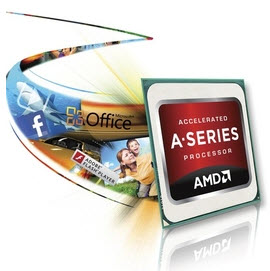New PlayStation 4 development kit contains an AMD 'heart': report


Sony has allegedly begun shipping new PlayStation 4 development kit called 'Orbis' to developers, and at the heart of this platform is an AMD accelerated processing unit (APU).
According to sources speaking to VG247, the new platform is described as a "modified PC" based on a derivative of AMD's A10-series APU. The A10 is a second-generation A-Series APUs, codenamed "Trinity", manufactured using a 32-nanometer process.
AMD currently has two A10 APUs in its line-up. There is the A10-4655M, which is a 25W TDP quad-core processor clocked at 2.0GHz -- but with turbo boost it can go to 2.8GHz -- and features a 4MB cache. The GPU is the HD 7620G and has 384 cores running at 497MHz. There's also the A10-4800M, AMD's most powerful part. This is another quad-core processor, clocked at 2.3GHz -- turbo boost to 3.2GHz -- and features a beefier HD 7660G GPU with 384 cores clocked at 686MHz.
According to the report, the "ultimate goal" for Sony's next-generation console is for it to be powerful enough to be able to run 1080p games in 3D with "no problem," to create a machine that is powerful enough for "today and tomorrow's market."
The current PlayStation 3 is powered by a Sony, Toshiba, and IBM-designed Cell processor, which consists of one 3.2 GHz PowerPC-based "Power Processing Element" and eight "Synergistic Processing Elements". Sony has sold some 63 million PlayStation 3 units since the console was launched in November 2006.
Another version of the developer kit is expected to be released to developers in January and this should be close to final specification of the release console. Developers will reportedly get their hands on the final platform sometime in summer 2013. This suggests that Sony could release the PlayStation 4 -- or whatever it ends up being called -- for the 2014 holiday season.
If AMD were to make its way into the next-generation console it would be a big win for the company and allow it to diversify and further distance itself from the stagnant PC market. AMD is already making plans to move into the ARM server market, and this could be further indication that AMD is looking to spread itself as far and as wide as possible.
Things have not been good for AMD lately, with the third quarter results coming in "weaker than expected" and the company shed around 15 percent of its workforce.
The report also claims that Sony's next-generation console will feature a Blu-ray optical drive, suggesting that the company is not yet ready to move to a digital distribution model just yet. This makes sense given that fast broadband connections are far from universal, and downloading 4GB or more of gaming data isn't something that the majority of Joe Average users are ready for.
Sony, along with games publishers, would like a shift to digital distribution because it would put a crimp on piracy, and also kill off the second-hand games market, both of which cut into profits.